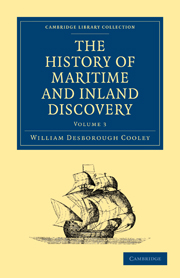Book contents
- Frontmatter
- Contents
- CHAP. I PROGRESS OF GEOGRAPHICAL SCIENCE
- CHAP. II VOYAGES OF BYRON, WALLIS, CARTERET, ETC
- CHAP. III COOK'S FIRST VOYAGE
- CHAP. IV COOK'S SECOND VOYAGE
- CHAP. V COOK'S THIRD VOYAGE
- CHAP. VI COOK'S THIRD VOYAGE CONTINUED
- CHAP. VII VOYAGE OF LA PEROUSE, ETC
- CHAP. VIII EUROPEANS IN THE SOUTH SEA
- CHAP. IX THE COASTS OF AUSTRALIA
- CHAP. X INTERIOR OF NEW HOLLAND
- CHAP. XI VANCOUVER'S VOYAGE
- CHAP. XII INTERIOR OF NORTH AMERICA
- CHAP. XIII ROSS AND PARRY
- CHAP. XIV PARRY'S VOYAGES
- CHAP. XV JOURNEY OF CAPTAIN FRANKLIN
- CHAP. XVI SECOND JOURNEY OF CAPTAIN FRANKLIN
- CHAP. XVII HUMBOLDT'S TRAVELS
- CHAP. XVIII HUMBOLDT'S TRAVELS CONTINUED
- CHAP. XIX SOUTHERN EXTREMITY OF AMERICA
- CHAP. XX EASTERN SHORES OF ASIA
- CHAP. XXI TRAVELS IN THE HIMALYEH
- CHAP. XXII BRUCE'S TRAVELS
- CHAP. XXIII PARK'S TRAVELS
- CHAP. XXIV DENHAM AND CLAPPERTON'S TRAVELS
- INDEX
CHAP. XV - JOURNEY OF CAPTAIN FRANKLIN
Published online by Cambridge University Press: 05 October 2010
- Frontmatter
- Contents
- CHAP. I PROGRESS OF GEOGRAPHICAL SCIENCE
- CHAP. II VOYAGES OF BYRON, WALLIS, CARTERET, ETC
- CHAP. III COOK'S FIRST VOYAGE
- CHAP. IV COOK'S SECOND VOYAGE
- CHAP. V COOK'S THIRD VOYAGE
- CHAP. VI COOK'S THIRD VOYAGE CONTINUED
- CHAP. VII VOYAGE OF LA PEROUSE, ETC
- CHAP. VIII EUROPEANS IN THE SOUTH SEA
- CHAP. IX THE COASTS OF AUSTRALIA
- CHAP. X INTERIOR OF NEW HOLLAND
- CHAP. XI VANCOUVER'S VOYAGE
- CHAP. XII INTERIOR OF NORTH AMERICA
- CHAP. XIII ROSS AND PARRY
- CHAP. XIV PARRY'S VOYAGES
- CHAP. XV JOURNEY OF CAPTAIN FRANKLIN
- CHAP. XVI SECOND JOURNEY OF CAPTAIN FRANKLIN
- CHAP. XVII HUMBOLDT'S TRAVELS
- CHAP. XVIII HUMBOLDT'S TRAVELS CONTINUED
- CHAP. XIX SOUTHERN EXTREMITY OF AMERICA
- CHAP. XX EASTERN SHORES OF ASIA
- CHAP. XXI TRAVELS IN THE HIMALYEH
- CHAP. XXII BRUCE'S TRAVELS
- CHAP. XXIII PARK'S TRAVELS
- CHAP. XXIV DENHAM AND CLAPPERTON'S TRAVELS
- INDEX
Summary
While captain Parry was employed in exploring a passage from Baffin's Bay to the Pacific, another expedition was despatched over land to ascertain the true position of the Coppermine River, and the windings of the shore to the eastward of it. This measure, which had apparently no great difficulties, seemed to promise eminent advantages to geographical science, and might prove serviceable to the intrepid navigator employed to the northward. Lieutenant (now captain) Franklin was selected to command this expedition, accompanied by Dr. Richardson, a gentleman well skilled in natural history; Mr. Hood, and Mr. Back, two midshipmen; and two English seamen.
Captain Franklin and his companions embarked in the end of May, 18193 and arrived in safety at York Factory, on the shores of Hudson's Bay, on the 30th of August. Preparations for their long and difficult journey were immediately commenced, and the information which the local experience of the fur traders could supply them was eagerly collected. On the 9th of September the journey commenced from York Fort, and on the 22d of October our travellers arrived at Cumberland House; a distance of 690 miles. Notwithstanding the lateness of the season, captain Franklin resolved to push forward to Fort Chepeweyan, near the western extremity of Athabasca Lake, in order that he might personally superintend the preparations for the journey of the ensuing summer. He accordingly set out with Mr. Back on the 18th of January, and arrived at the fort on the 26th of March; thus performing a journey of 857 miles in the very depth of winter; the thermometer frequently sinking to forty and sometimes more than fifty degrees below zero.
- Type
- Chapter
- Information
- The History of Maritime and Inland Discovery , pp. 223 - 234Publisher: Cambridge University PressPrint publication year: 2010First published in: 1831

